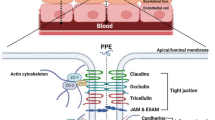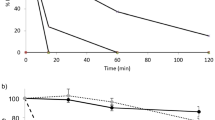Abstract
In this study the intestinal degradation and absorption of a synthetic pentapeptide, metkephamid, were investigated in the rat by determination of its wall permeabilities in the small and large intestine and the extent and mechanism of its intestinal degradation. The peptide was metabolized in the gut wall through contact with membrane-bound enzymes in the brush border membrane. The extent of metabolic inactivation depended on the intestinal segment investigated and decreased in the axial direction. No metabolism was found in the colon. The dimensionless wall permeabilities (P w*), determined by single-pass perfusion, were also site dependent. P w* was highest in the ileum [1.91 ± 0.24, (SE); n = 4], followed by the jejunum (1.64 ± 0.34; n = 4) and the colon (0.67 ± 0.38; n = 4). Based on the permeability data alone and under the assumption of no presystemic metabolism, complete bioavailability would be predicted for metkephamid. However, following oral administration, the mean absolute bioavailability was only 0.22 ± 0.065% (n = 3), indicating the overall dominance of degradation in the absorption process. Thus future strategies in oral peptide delivery should focus on increasing the stability of the peptide in the intestine by modifying the peptide structure and/or delivering the compound to an intestinal segment showing little or no enzymatic degradation.
Similar content being viewed by others
REFERENCES
K. S. E. Su, K. M. Campanale, L. G. Mendelsohn, G. A. Kerchner, and C. L. Gries. Nasal delivery of polypeptides. I. Nasal absorption of enkephalins in rats. J. Pharm. Sci. 74:394–398 (1985).
M. J. Humphrey. The oral bioavailability of peptides and related drugs. In S. S. Davis, L. Illum, and E. Tomlinson (eds.), Delivery Systems for Peptide Drugs, Plenum Press, New York, 1986, pp. 139–151.
P. Langguth, V. Bohner, J. Biber, and H. P. Merkle. Metabolism and transport of the pentapeptide metkephamid by brush-border membrane vesicles of rat intestine. J. Pharm. Pharmacol. 46:34–40 (1994).
M. Hu, P. J. Sinko, A. L. J. DeMeere, D. A. Johnson, and G. L. Amidon. Membrane permeability parameters for some amino acids and β-lactam antibiotics: Application of the boundary layer approach. J. Theor. Biol. 131:107–114 (1988).
H. Hauser, K. Howell, R. M. C. Dawson, and D. E. Bowyer. Rabbit small intestinal brush border membrane preparation and lipid composition. Biochim. Biophys. Acta. 602:567–577 (1980).
S. A. Kaplan and L. M. Jack. In vitro, in situ and in vivo models in bioavailability assessment. In J. Blanchard, R. J. Sawchuck, and B. B. Brodie (eds.), Principles and Perspectives in Drug Bioavailability, S. Karger AG, Basel, 1979, pp. 156–191.
D. A. Johnson and G. L. Amidon. Determination of intrinsic membrane transport parameters from perfused intestine experiments: A boundary layer approach to estimating the aqueous and unbiased membrane permeabilities. J. Theor. Biol. 131:93–106 (1988).
M. Gibaldi and D. Perrier. Pharmacokinetics, Dekker, New York, 1982.
C. M. Metzler and D. L. Weiner. PCNONLIN, SCI Software, Lexington, KY, 1992.
R. C. Reiz, J. M. Prausnitz, and T. K. Sherwood. The Properties of Gases and Liquids, McGraw-Hill, New York, 1977, pp. 57–59.
B. J. Aungst, J. A. Blake, and M. A. Hussain. An in vitro evaluation of metabolism and poor membrane permeation empeding absorption of leucine enkephalin and methods to increase absorption. J. Pharmacol. Exp. Ther. 259:139–145 (1991).
S. D. Kashi and V. H. L. Lee. Enkephalin hydrolysis in homogenates of various absorptive mucosae of the albine rabbit: Similarities in rates and involvement of aminopeptidases. Life Sci. 38:2019–2028 (1986).
D. I. Friedman and G. L. Amidon. Oral absorption of peptides: Influence of pH and inhibitors on the intestinal hydrolysis of Leu-enkephalin and analogues. Pharm. Res. 8:93–96 (1991).
L. E. Geary, K. S. Wiley, W. L. Scott, and M. L. Cohen. Degradation of exogeneous enkephalin in the guinea-pig ileum: Relative importance of aminopeptidase, enkephalinase and angiotensin converting enzyme activity. J. Pharmacol. Exp. Ther. 221:104–111 (1982).
T. Palmer. Understanding Enzymes, 3rd ed., Ellis Horwood, New York, 1991, pp. 206–207.
M. L. Bender and L. J. Brubacher. Catalysis and Enzyme Action, McGraw-Hill, New York, 1973, p. 76.
D. Schomburg and M. Salzmann. Enzyme Handbook 5: Hydrolases, Springer Verlag, Berlin, 1991.
S. Miura, I.-S. Song, A. Morita, R. H. Erickson, and Y. S. Kim. Distribution and biosynthesis of aminopeptidase N and dipeptidylaminopeptidase IV in rat small intestine. Biochim. Biophys. Acta 761:66–75 (1983).
S. A. Adibi and Y. S. Kim. Peptide absorption and hydrolysis. In L. R. Johnson (ed.), Physiology of the Gastrointestinal Tract, Raven Press, New York, 1981, pp. 1073–1095.
S. Aurichio, L. Greco, B. de Vizia, and V. Buonocore. Dipeptidylaminopeptidase and carboxypeptidase activities of the brush border of rabbit small intestine. Gastroenterology 75:1073–1079 (1978).
N. Triadou, J. Bataille, and J. Schmitz. Longitudinal study of the human intestinal brush border membrane proteins. Gastroenterology 85:1326–1332 (1983).
G. L. Amidon, P. J. Sinko, and D. Fleisher. Estimating human oral fraction dose absorbed: A correlation using rat intestinal membrane permeability for passive and carrier-mediated compounds. Pharm. Res. 5:651–654 (1988).
S. Lundin, N. Pantzar, A. Broeders, M. Ohlin, and B. R. Weström. Differences in transport rate of oxytocin and vasopressin analogues across proximal and distal isolated segments of the small intestine of the rat. Pharm. Res. 8:1274–1280 (1991).
V. S. Chadwick, S. Phillips, and F. Hofmann. Gastroenterology 73:247–251 (1977).
S. Lundin and H. Vilhardt. Absorption of 1-deamino-8-D-arginine vasopressin from different regions of the gastrointestinal tract in rabbits. Acta Endocrinol. 112:457–460 (1986).
L. G. Roda, G. Roscetti, R. Possenti, F. Venturelli, and F. Vita. Control mechanisms in the enzyme hydrolysis of adrenal-released enkephalins. In N. P. Plotnikoff, R. E. Faith, A. J. Murgo, and R. A. Good (eds.), Enkephalins and Endorphins. Stress and the Immune System, Plenum Press, New York, 1986, pp. 17–33.
A. J. Kenny, S. L. Stephenson, and A. J. Turner. Cell surface peptidases. In A. J. Kenny and A. J. Turner (eds.), Mammalian Ectoenzymes, Elsevier, Amsterdam, 1987, pp. 169–210.
Author information
Authors and Affiliations
Rights and permissions
About this article
Cite this article
Langguth, P., Merkle, H.P. & Amidon, G.L. Oral Absorption of Peptides: The Effect of Absorption Site and Enzyme Inhibition on the Systemic Availability of Metkephamid. Pharm Res 11, 528–535 (1994). https://doi.org/10.1023/A:1018962415287
Issue Date:
DOI: https://doi.org/10.1023/A:1018962415287




